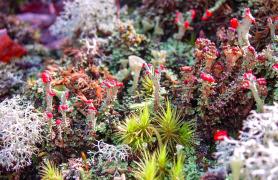The weasel family is the world’s largest group of meat eating mammals. The clan includes weasels, minks, otters, badgers, martens, fishers, ferrets, and wolverines. Weasels and their kin are found on every continent except Australia and Antarctica. Five species live in Missouri. Although members of the family come in various shapes and sizes, they all have one thing in common: They make their living by hunting and killing other animals, and most prefer their prey to be alive and quivering until just before dinner.
Least Weasel
Tiny but Bitey
Barely bigger than a bratwurst, least weasels are the world’s smallest meat-eating mammals. At birth, baby weasels weigh about as much as raisins. As adults, they’re about as big as skinny hamsters and can squeeze through holes less than 1 inch wide. But don’t let their small size fool you. Ounce for ounce, least weasels bite harder than any other North American mammal. They use their burly bite muscles — and sharp teeth — to pierce the skulls of the mice and voles that they eat.
Hunger Games
What’s that rumbling sound? It’s probably a least weasel’s stomach growling. To fuel their ferocity, weasels eat more than half their body weight each day. To keep up with a weasel’s oversized appetite, an average 10-year-old human would have to eat nearly 150 quarter-pound hamburgers every 24 hours.
Quick-Change Artists
Least weasels are found as far north as Alaska and as far south as Missouri. In northern parts of their range, these feisty mouse-munchers — and their close cousins, long-tailed weasels — trade their brown summer coats for white winter fur. This helps them sneak through the snow undetected to catch their prey. In Missouri, weasels usually grow just a pale brown coat in winter, but a few turn completely white.
Long-Tailed Weasel
The Hunter Becomes the Hunted
Weasels are usually the ones doing the killing, but because of their small size, they sometimes end up as prey. Hawks, owls, foxes, coyotes, bobcats, house cats, snakes, and even mink will snack on a weasel if given the chance.
Fast and Furious
Long-tailed weasels are as nimble as ninjas and attack so swiftly that prey is usually caught off guard. Although mice and rats make up most of their diet, these slim, foot-long predators regularly bring down rabbits and other animals much larger than themselves. Once a weasel pounces on its prey, it wraps its body around the victim and bites so rapidly that it’s hard to follow the action with the human eye. The weasel eventually works its way to the head where it delivers a knockout bite to the spine or neck.
American Mink
Stinky Minky
Like most members of the weasel family, mink are armed with a pair of musk glands on their furry backsides. The glands produce a stinky odor that some people think smells worse than a skunk’s spray.
All-Terrain Predators
Mink feel at home both on land and in water. Their skinny, tube-shaped bodies help them wiggle into narrow nooks and crannies to surprise rodents in their burrows. They can swim underwater for at least 50 feet and paddle fast enough to chase down fish. Mink are so at ease in the water, they’ve been known to float down streams curled up in balls, apparently sound asleep.
American Badger
Built Like a Bulldozer
Badgers use their sharp, 1-inch-long claws and powerful muscles to dig up their dinner of voles, gophers, and ground squirrels. They loosen soil with their front paws, pass it under their bellies, and shovel it out of the hole with their back paws, often kicking debris nearly 5 feet into the air. At full speed, the furry dirtdrills can disappear underground in less than a minute and can even dig faster than a human with a shovel.
Hunting Buddies
Badgers and coyotes sometimes hunt together. The toothy teammates spell double the trouble for ground squirrels and other tunnel dwellers. Why? If a squirrel scurries out of its burrow, the crafty coyote pounces on it. But if the squirrel stays put, the burly badger digs it up for dinner. north American river otter
Angling Adaptations
Have you ever tried to catch a fish — with your mouth? Luckily, river otters have a few tricks to give them the upper paw. Otters have webbed feet that act like paddles and thick tails that act like rudders. Their streamlined bodies can twist into turns so tight it would make a ballet dancer dizzy. Bushy whiskers help them feel food in murky water. And nose clips aren’t needed — otters simply squeeze their snouts shut. To top it off, an otter can hold its breath for 4 minutes, which is plenty of time to nab some sushi for supper.
Swimming Lessons
It’s hard to believe, but baby river otters don’t know how to swim. It’s up to mom to teach them. Otter pups aren’t enthusiastic students. In fact, they’re often scared of water, so mom must sometimes drag them in. She patiently teaches each pup first to float, then to paddle at the surface, and finally to dive.
When the lesson is over, the pups return to their den for milk and a well-deserved nap.
Snow Sliders
Who needs a sled when you have a furry belly? To move through the snow, otters build up speed then tuck their legs to the side and sliiiiide. If a slope is really slick, otters slide down it over and over just for fun. In addition to the joy of sliding, the playful predators also amuse themselves with rocks and mussel shells in the water, tossing them up and then diving down to catch them.


















Also In This Issue

This Issue's Staff
Les Fortenberry
Karen Hudson
Angie Daly Morfeld
Noppadol Paothong
Marci Porter
Mark Raithel
Laura Scheuler
Matt Seek
David Stonner
Nichole LeClair Terrill
Stephanie Thurber
Cliff White






















